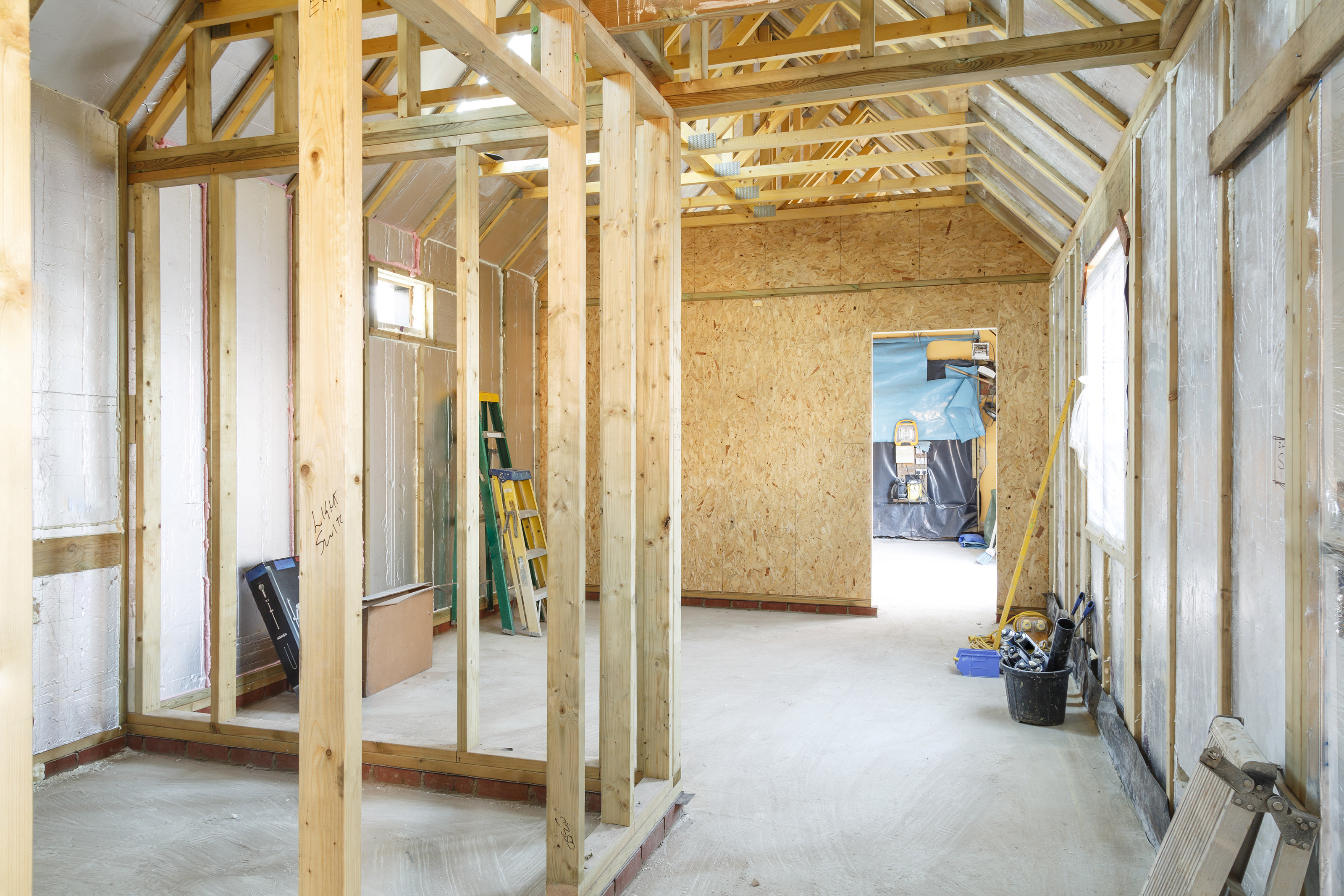7 housing market predictions and homebuilding trends for 2024
From house prices to building materials, we glean expert insight as we make these housing market predictions for the year ahead

As we approach 2024 we take a look at the biggest changes and trends that are set to hit the UK housing market.
Whilst building materials prices and house prices are predicted to continue on their 2023 trajectories, 2024 could bring some welcome surprises, particularly to those looking to self build with a number of planning regulation changes set to be introduced as well as growing trends for eco-friendly products in homes.
We anticipate our top housing market predictions for 2024 and highlight the key areas where you could be affected on your homebuilding and/or renovating journey in the new year.
1. House prices expected to continue their decline
House prices are expected to continue their 2023 decline in prices into 2024 with prices predicted to fall by 2-4%, according to Halifax.
Housing affordability dropped significantly in 2023 with the Bank Rate rising to 5.25% causing mortgage rate rises. This led to a decline in sales and a subsequent decline in asking prices.
Kim Kinnaird, Director at Halifax Mortgages, stated: “UK property prices held up better than expected over the last year, falling by just 1.0% on an annual basis, to now sit at £283,615.
“Looking ahead, now that inflation is falling back, financial markets are pricing in cuts to Base Rate during 2024. Mortgage rates are already falling, with a typical 5-year fixed 75% LTV deal now below 5%, having been as high as 5.7% as recently as July. All being equal, these rates are expected to fall further over the coming months.
Get the Homebuilding & Renovating Newsletter
Bring your dream home to life with expert advice, how to guides and design inspiration. Sign up for our newsletter and get two free tickets to a Homebuilding & Renovating Show near you.
"Overall, with the combination of cost of living pressures and interest rate levels that are still much higher than even two years ago, we will likely see continued mild downward pressure on house prices. Our latest forecast suggests a fall of between -2% and -4% in 2024, though it should be noted, as with recent years, forecast uncertainty remains high given the current economic environment.”

Kim Kinnaird holds the position of Banking and Trade Delivery Director within the Commercial Bank at Lloyd Banking Group. In her role she oversees the service teams responsible for managing the daily banking requirements of Commercial Banking clients, with a primary focus on cash management, payments, and comprehensive servicing of trade products for Lloyd's business clients.

According to Rightmove the decline in housing market activity seen in 2023 is a return to normal levels of activity following the frenetic post-pandemic period.
Rightmove predicts that average new seller asking prices will be 1% lower by the end of 2024, as competition increases among sellers to find a buyer.
Tim Bannister, Rightmove's Director of Property Science, says: “It’s likely to be another muted year for the market, however the better than anticipated activity this year has shown that many buyers are still getting on with satisfying their housing needs. We predict a modest average 1% fall in new seller asking prices in 2024. The underlying level of good demand at the right price makes it unlikely that we will see a more significant drop in prices next year.”
Lloyds and Halifax predict that the Base Rate will be cut in 2024 and reduce mortgage costs, which currently stand at 5% for a 5-year fixed 75% LTV deal increasing the affordability for those looking to buy a house or gain a self build mortgage.

Tim Bannister joined Rightmove in 2010, initially working in our lettings division before transitioning his focus to insights. As the current Director of Property Science, Tim leverages data, technology, and analytics to create distinctive insights that inform and guide property-related decision-making processes.
2. Building material prices expected to rise
Building materials prices in 2024 may not provide the news self builders and those looking to renovate a house were hoping for.
Construction market analysts, Glenigan published their industry forecast for 2024 that predicts there will be an 8% increase in construction levels from 2023 levels, which in turn will create higher demand for construction materials, raising prices further.
Glenigan’s economics director Allan Wilén commented: “Renewed construction growth is forecast for 2024 and 2025 as a strengthening UK economy lifts consumer and business confidence."
A Federation of Master Builders (FMB) survey for 2023 of SME (small and medium-sized enterprises) discovered that 43% found material costs to be the fourth biggest obstacle to the building of new homes, and 55% stated that they believe the Future Homes Standard in 2025 will cause increased material costs next year in anticipation of its arrival.
3. Low carbon building materials set to rise
As wider building materials rise in prices environmentally friendly building materials are set to become even more popular in the UK homebuilding sector in 2024.
The government has highlighted the need to reduce carbon emissions, particularly from the UK's built environment, which contributes 25% of the country's carbon emissions.
Low-impact materials are being encouraged and invested into in the UK with advanced composites (high-performance building materials) predicted to be more widely used. A number of these were introduced to the UK market in 2023 including a carbon neutral brick and ultra low carbon LC3 cement.
The government has also launched a 'Timber in Construction Roadmap' aiming to encourage the use of timber rather than concrete in construction as it will store carbon inside buildings and help meet net zero targets.
Timber Development UK CEO David Hopkins said: "Timber construction has been recognised as essential to tackling built environment emissions by key advisory bodies such as the Environmental Audit Committee and Climate Change Committee. We are delighted to see the government action the recommendations of these bodies through the long-awaited Timber in Construction Policy Roadmap.
"By expanding low-carbon timber construction, particularly in the housing sector, we can decarbonise our built environment whilst simultaneously building high-quality, efficient buildings."

4. Energy bills to fall for most of 2024
In 2023 we saw the end of the Energy Price Guarantee on July 1st as it was superseded by the energy price cap.
The cap currently stands at £1,834 but Ofgem have announced from January 1 this is set to increase by 5% to £1,928.
Jonathan Brearley, CEO of Ofgem, said this was due to "the wholesale cost of gas and electricity rising, which needs to be reflected in the price that we all pay".
However, government estimates published in the House of Commons Library predict gas and electricity prices to fall back to £1,800 for the rest of 2024.
The energy price cap will be updated in April, July, and October so until then homeowners are advised to follow energy saving tips such as using energy efficient appliances.
5. Levelling Up Regeneration Act changes
As the Levelling Up and Regeneration Act was passed in October, which focussed on speeding up planning applications for residents and local authorities in what the Housing Secretary Michael Gove described as being a "landmark" legislation.
The act introduces streamlined and focused planning in the early stages, aiming for plans to be adopted within 30 months with reduced evidence requirements.
Local planning authorities are also now required to create design codes for their areas, empowering residents to propose and implement property redevelopment plans through 'street vote' powers.
The Bill also brings various reforms, including flexible national housing targets, strengthened Green Belt protections, prioritisation of brownfield sites, the introduction of a new Community Infrastructure Levy, and penalties for slow developers.
Neighbourhood plans are also planned to be strengthened, and the obligation on local authorities to maintain a rolling five-year supply of housing land will end if local plans are not up-to-date.
6. Rise in renewable energy
Despite heat pump sales suffering in the first half of 2023 the renewable heating system experienced a boost in the second half of 2023, not least helped by the increase in the Boiler Upgrade Scheme that now provides grants worth £7,500.
This decision marked a 50% increase in the government's contributions towards installations for air source heat pumps, which resulted in heat pump applications tripling.
Solar PV (Photovoltaic) panels also saw a 15% increase in installations in 2023 with with many homeowners continuing to benefit from the Smart Export Guarantee where homeowners can get paid for excess electricity they generate and send back to the grid. The rise in solar panels is also expected to continue into 2024.
Hydrogen boilers will undergo trials in 2024 to assess their suitability for reducing carbon emissions in the UK as a hydrogen village will be tested in Fife where around 1,000-2,000 properties will be converted to hydrogen for heating instead of natural gas.
This will be used as evidence to assess the effectiveness of using hydrogen in heating systems as part of a two-year trial in preparation for a nationwide roll-out in 2026.
All new homes will also be required to produce around 30% less carbon dioxide emissions in order to meet Building Regulations.

7. Nutrient neutrality set to be scrapped
Nutrient neutrality laws could be banished in 2024 with developers and government figures backing its removal.
The Housing Forum (membership group for home building associations) published a report calling for the removal of nutrient neutrality rules from the planning system due to the delays it caused in planning applications.
Stewart Baseley, executive chair of the HBF, supported this view claiming nutrient neutrality was "exacerbating another national crisis, our shortage of homes".
Jeremy Hunt announced in his autumn statement £110 million worth of nutrient mitigation funding to help councils process applications and deal with the "backlog" of planning applications caused by the scheme.
However, Michael Gove has outlined his support for removing them altogether siding with developers who have called for their removal.
The government's attempts to restrict nutrient neutrality laws in September 2023 were stopped by the House of Lords, but this could be a matter of time with many Conservative figures backing the proposal to drop Nutrient Neutrality laws.
Nutrient neutrality calculations and assessments will be updated on January 26, 2024 by Natural England.

News Editor Joseph has previously written for Today’s Media and Chambers & Partners, focusing on news for conveyancers and industry professionals. Joseph has just started his own self build project, building his own home on his family’s farm with planning permission for a timber frame, three-bedroom house in a one-acre field. The foundation work has already begun and he hopes to have the home built in the next year. Prior to this he renovated his family's home as well as doing several DIY projects, including installing a shower, building sheds, and livestock fences and shelters for the farm’s animals. Outside of homebuilding, Joseph loves rugby and has written for Rugby World, the world’s largest rugby magazine.
